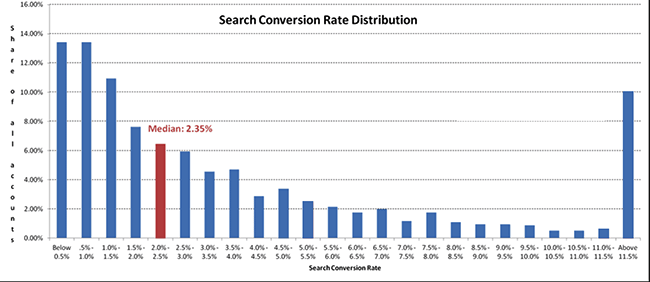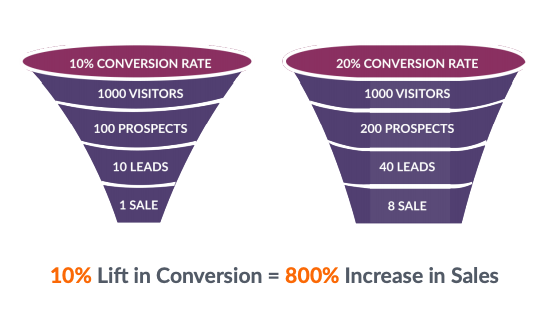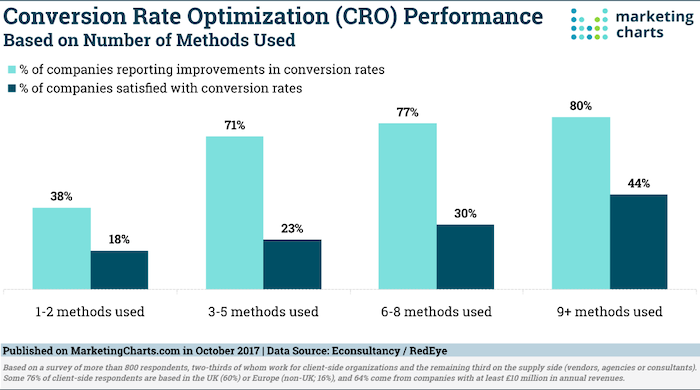Your website can be your strongest sales asset or your weakest link.
A high-converting website works even when you’re sleeping, bringing in sales and growing your business 24 hours a day.
While the average conversion rate is around two to five percent, some of the highest performing websites online see conversion rates as high as 11 percent.
This means top advertisers are outperforming competitors by more than double.
If you want to increase your conversion rates, you need a strong CRO program to guide you.
A CRO program can improve ROI for your e-commerce business by targeting website performance and testing user experience methods that encourage online conversions.
Below, we’ll cover why CRO programs matter, how to create them, and what success in this space really looks like.

What Is a CRO Program?
Conversion Rate Optimization (CRO) programs are digital marketing strategies that help to improve conversion rates on websites or apps.
Usually, a CRO program finds drop-off points or obstacles on a website, analyzes how and why they are occurring, and then helps you develop new ways to ensure future conversions.
This is done through A/B testing, data analysis, customer journey mapping, consumer research, and more.
The key is to figure out:
- what brings people to your website
- what barriers they face when they arrive
- what persuades them to convert
- how can you repeat this conversion with other similar guests
From there, tactics such as analytics, PPC tracking, heat mapping, and user recordings help read on-site behaviors.
Using a combination of these tools and pairing them with a testing schedule is one of the most effective ways to improve your website conversion rates.
Why Are CRO Programs Important?
CRO programs are essential to growth because they improve customer experience, conversions, and sales.
Conversion rate optimizations can even lower your customer acquisition cost by improving conversion rates with visitors already on your site.
For example, if your website gets 1000 visitors a month and has a five percent conversion rate, you’ll get 50 conversions per month. If you can increase your conversion rate by five percent, you’ll double your monthly conversions without spending more to acquire new customers. You can see this at work in this conversion rate optimization funnel.

CRO programs give you insights into what is working on your website and what is not, allowing you to optimize your budget allocations.
As competition online grows, CRO programs are becoming increasingly important.
These days, it isn’t enough to offer a good product or service; you also need an engaging website that loads quickly, funnels users towards your end goals, and offers value and insight.
According to Unbounce, 70 percent of consumers report a slow load time decreases their chance of buying. From that same cohort, 32.3 percent claimed they are only willing to wait four seconds for a page to load.
Seventy-seven percent of mobile shoppers say they are more likely to purchase from websites that allow them to purchase quickly.
Well-placed CTAs can increase website conversions by 232 percent.
A strong CRO program can tackle all of these solutions while putting user experiences first and creating a clear framework for improving on-site experiences.
Once you understand how, when, and why your customers enter or exit your site, you’ll be able to make improvements to help it reach its maximum potential.
With a well-structured CRO program, you have the ability to:
- Improve the speed and quality of your website.
- Improve long-term revenue without long-term investments.
- Personalize on-site experiences for your customers.
- Capture new insights into visitor and customer behavior.
Who Should Consider Starting a CRO Program?
Any business that wants to improve its online conversions can benefit from a CRO program.
More specifically, CRO programs are great for e-commerce businesses, businesses with email marketing programs, and businesses involved in paid media programs, as CRO is a natural accompaniment to these programs.
CRO programs can also improve SEO efforts, as they improve page load times, on-page performance, UX/UI, and readability.
Any business looking to improve its online conversions or SEO can benefit from a CRO program. This list can include:
- B2C e-commerce businesses
- B2B businesses looking to increase online leads
- blogs and listing sites looking to improve SEO
- agencies and marketers running paid media campaigns for clients
- agencies and marketers servicing digital-based clients
- SaaS companies looking to drive online downloads
- educational institutions that want to attract new students
- hotels and hospitality organizations looking to improve bookings
Businesses that stand to see the largest benefits from CRO programs are those that have a large number of monthly web visitors.
CRO programs usually work best with scale. For example, a five percent increase in conversion rate on a site with 100 monthly visitors is only five extra conversions per month. Yet, a five percent increase on a site with 100,000 monthly visitors is 5,000 extra conversions per month.
Additionally, CRO programs are most effective for websites with one clearly defined goal. For example, an e-commerce website looking to sell more products, a B2B business may want to increase demo appointments or drive email sign-ups. Whatever your goal, it should be obvious to incoming visitors.
Keep in mind CRO programs are best suited for businesses seeking to build long-term value. Clients need to understand the value of their website and how it affects consumer relationships. Using several CRO strategies, for example, is often more effective but those strategies take time.

Drawbacks to CRO Programs
While CRO programs can be incredibly helpful to growing businesses, there are some drawbacks.
First, CRO programs can be costly and time-consuming. It’s not about quick wins, but rather ongoing testing, optimization, and education.
Many businesses don’t have the internal expertise to launch a CRO program. This often means hiring third parties is necessary, which increases the cost.
For those with in-house expertise, it can be difficult to shift resources towards a dedicated CRO program.
For businesses on a tight budget, or those without time to oversee these programs, CRO programs may end up being unfulfilling.
That said, creating a structured CRO program can alleviate some of the costs and drawbacks associated.
Below, we’ll outline some of the steps needed to integrate a CRO program into your business.
How to Create a CRO Program
Research shows that the top marketers in the world set clear goals and that goal-setting marketers are 375 percent more likely to report success.
If you’re ready to start your own CRO program, you’ll want to lead with strategy.
Here’s how to get started.
- Establish a CRO Culture
For a CRO program to be successful, you need buy-in from top members of your organization and staff.
Top management controls budget, resource allocation, and sign-offs for your programs. Cooperation on this level is essential to see a CRO program through from start to finish.
Likewise, coordination with team members and among departments will be necessary to complete your program. CRO programs often include members of data management teams, UX teams, webmasters, and customer support.
To ensure your CRO program runs smoothly, educate all team members and higher-ups on the goals and benefits of the CRO.
- Hire People Who Align With CRO Principles
CRO programs often involve data, strategy, design, copywriting, and web development.
If you know your company is interested in CRO, establish this in your hiring processes.Even better, search out top talent well-versed in CRO and consult their expertise when considering new team members.
The more alignment you have with your team from the start, the more likely you will see success in your CRO program.
- Document and Adhere to the CRO Process
A successful CRO program requires a well-defined process.
This process should start by outlining key issues on your existing website and how they contribute to gains and losses in your conversion funnel.
From there, develop hypotheses to tackle these issues, and design a calendar to keep your team on schedule.
Your entire process should revolve around A/B testing. Once you start testing, you’ll likely find more places to optimize. Document these opportunities in as much detail as possible, then add them to your calendar.
Pay attention to any new opportunities for optimization and ensure every decision is data-backed and aligned with your overall business goals.
- Use CRO Tools
Whether you plan to watch visitor activities on your website through heatmaps or want to know how your lead forms are performing, CRO tools are an essential part of your program.
CRO tools show an average ROI of 223 percent, so don’t be afraid to invest a bit of money to get the tools you need.
Here are a few CRO tools to consider:
-heat maps
-scroll maps
-A/B testing tools
-multi variant testing tools
-split testing tools
-funnel analysis tools
-Google Analytics
-form analysis tools
-visitor recording tools - Use CRO Research Methodology for Applicable Tasks
All good CRO programs start with research.
This can come in three forms:
-experience research
-qualitative research
-quantitative researchExperience research usually involves site walkthroughs, usability analysis, and heuristic analysis to understand the workings of your existing site.
Qualitative research may use online surveys, polls, customer support insights, and user testing to understand how your users interact with your site and what makes them leave.
Quantitative research involves web analytics and mouse tracking to see exactly where and how users convert.This data will give you the foundation for your CRO program and let you know exactly where to focus your efforts.
From there, it’s all about testing, re-testing, and optimizing your website.
How to Measure the Success of Your CRO Program
While increased conversions are the most obvious metric of CRO success, too much focus on conversions can lead your CRO program astray.
Other metrics, such as bounce rates, time on site, shopping cart abandonment, cost per conversion, and clicks should be considered when measuring the success of your CRO program.
Remember, what matters most is the quality of conversions, not the quantity.
It often costs far more to bring in new customers than to keep the ones you already have. Similarly, a five percent increase in customer retention can increase your profitability by 75 percent.
Focus your CRO program on customer engagement, experience, and retention, and you’ll be on the road to success.
Conclusion
CRO programs are an effective tool to improve online conversions.
While they are a big investment, both in time and money, a good CRO program can uncover so many opportunities for business growth.
Whether you choose to run your CRO program in-house or hire a dedicated CRO company, this guide will set you up for success.
As a final note, remember that CRO and SEO can work hand-in-hand when done right.
Don’t be afraid to test and experiment widely with both. You never know what you might uncover.
Have you found success in a CRO program?